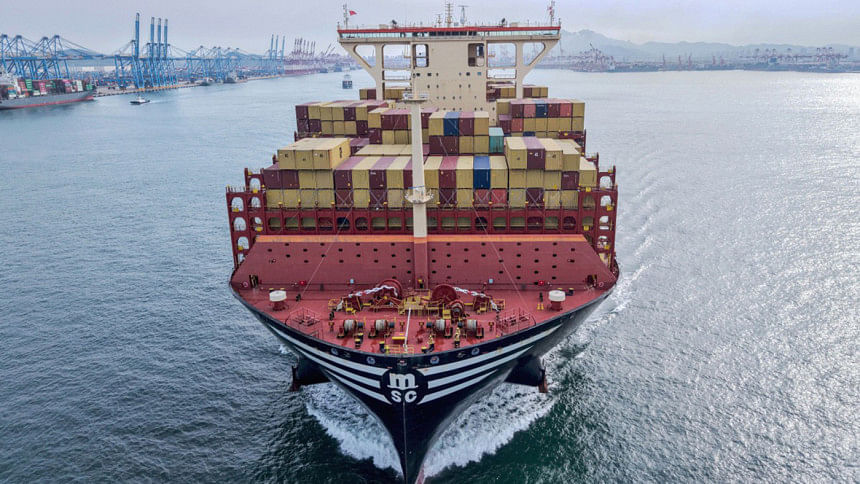Google Alert – বাংলাদেশ
Expects rise in investments, exports as India faces 50% tariff
A cargo ship loaded with containers leaves the port in Qingdao, in eastern China’s Shandong province on May 7, 2025. Photo: AFP
“>
A cargo ship loaded with containers leaves the port in Qingdao, in eastern China’s Shandong province on May 7, 2025. Photo: AFP
The new tariff on US-bound exports from Bangladesh came into effect yesterday, with hopes of maintaining a healthy flow of garment shipments to the American market.
With this, the effective tariff rate (ETR) for Bangladeshi goods exported to the United States now stands at 36.5 percent, comprising the newly imposed 20 percent reciprocal rate and the existing 16.5 percent tariff.
However, for Bangladeshi exporters, using the advantages of the new rate can mean a stitch in time since some of its regional competitors face similar or higher tariffs imposed by the Trump administration.
The finalisation of the rate has already begun yielding results, as major American retailers and brands have started confirming work orders for upcoming summer and autumn seasons, industry insiders said. Currently, local garment exporters are busy shipping consignments for the Christmas season in the US.
The Trump administration imposed the same 20 percent reciprocal tariff on Vietnam, currently the second-largest apparel supplier to the US, bringing its ETR to 36.5 percent as well. However, goods transshipped through Vietnam now face a 40 percent duty, offering Bangladesh a competitive edge.
India, the fourth-largest apparel supplier to the US, is set to face a 50 percent reciprocal tariff in the coming weeks, raising its total ETR to 66.5 percent. Meanwhile, China, the largest supplier, currently faces a 55 percent tariff, with negotiations on a reciprocal rate still ongoing.
These developments are expected to divert a notable volume of US apparel orders from India and China to Bangladesh.
“This is a better opportunity,” said Faisal Samad, managing director of Surma Garments Ltd and director of the Bangladesh Garment Manufacturers and Exporters Association (BGMEA). “Retailers and brands, who were earlier confused, are now coming back with higher volumes of orders.”
He, however, stressed the need for strategic marketing, improved price negotiation, and better promotion and branding of both the sector and the country to fully leverage the opportunity.
Showkat Aziz Russell, president of the Bangladesh Textile Mills Association (BTMA) who was a private sector representative in the final round of negotiations with the US Trade Representative (USTR), said Bangladesh has committed to reducing the bilateral trade gap by 75 percent as soon as possible.
Bangladesh currently exports over $8.2 billion worth of goods to the US annually, while importing just over $2 billion, resulting in a trade gap of about $6 billion.
“This gap can be narrowed,” Russell said, citing cotton imports as one example. Bangladesh imports $4 billion worth of cotton globally every year, but only 5 percent comes from the US. “If we start sourcing $1 billion worth of US cotton, the gap will shrink significantly,” Russell said.
He also requested the US government to allow “Made from US cotton” tags on Bangladeshi apparel to enable exporters to claim additional tariff benefits. Use of US cotton in production can unlock special treatment under the new tariff regime, he added.
Beyond cotton, Russell pointed to Bangladesh’s potential to import more US-made products, including LPG, soybean, wheat, agricultural goods, and even aircraft, to help balance trade. “Of course, Bangladesh will enjoy the spillover effects of the higher tariffs on China and India,” he noted.
Mohammed Amirul Haque, chairman of Seacom Group and another private sector member of the Bangladeshi negotiation team, said the country is now in a more favourable position in terms of ETR.
“A new door of opportunity has opened. This is a great achievement for Bangladesh,” he said. “In reality, both countries will benefit from this arrangement.”
Still, exporters face challenges. As countries like China and India redirect their shipments to Europe at lower prices due to US tariffs, Bangladeshi suppliers may face stiffer competition in the European Union market, where they export over $25 billion annually. This could lead to additional price pressure from European buyers.
Moreover, demand for apparel in the US could fall due to inflation and rising prices, potentially affecting future shipments.
Mohammad Abdur Razzaque, economist and chairman of the Research and Policy Integration for Development, warned that a downturn is possible. “When the Trump administration imposed a 25 percent tariff on Chinese goods in 2018, US apparel imports fell,” he said.
The US used to import $105 billion worth of garments annually, but by 2024, that figure had declined to $85 billion, he added.




 For all latest news, follow The Daily Star’s Google News channel.
For all latest news, follow The Daily Star’s Google News channel.